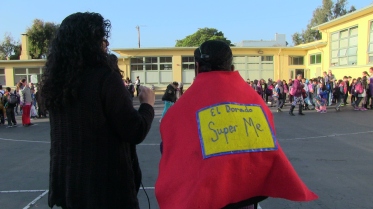
El Dorado Elementary School Principal Silvia Cordero announces one of the winners of the weekly student-of-the-week award.
____________________________
For one young student – let’s call him Martin — the 2012-2013 school year at El Dorado Elementary in the Visitacion Valley neighborhood of San Francisco was a tough one, recalls Joyce Dorado, director of UCSF HEARTS — Healthy Environments and Response to Trauma in Schools.
“He was hurting himself in the classroom, kicking the teacher, just blowing out of class many times a week.” There was good reason. The five-year-old was exposed to chronic violence and suffered traumatic losses. His explosions were normal reactions to events that overwhelmed him.
This year, Martin’s doing better. That’s because he spent months working with a HEARTS therapist, and that therapist  worked with his teachers and other school staff to create a more safe and supportive learning environment. Still, on days when he feels extremely anxious, Martin sometimes asks to visit the school’s Wellness Center, a small, bright room stocked with comforting places to sit, headphones to listen to music, and soft and squishy toys.
worked with his teachers and other school staff to create a more safe and supportive learning environment. Still, on days when he feels extremely anxious, Martin sometimes asks to visit the school’s Wellness Center, a small, bright room stocked with comforting places to sit, headphones to listen to music, and soft and squishy toys.
“If a student starts to lose it, the teacher can give the kid a pass to go to the Wellness Center,” says Dorado. “The kid signs in, circles emotions on a ‘feelings’ chart (to help the person who staffs the center understand how to help the child). The staff member starts a timer. The kid gets five to 10 minutes. The kid can sit on the couch with a blanket, listen to music, squeeze rubber balls to relieve tension and anger, or talk to the staff member. Kids who use the room calm down so that they can go back to class. It’s not a punishment room. It’s not a time-out room. It’s not an in-school suspension room. It’s a room where you feel better going out than when you went in.”
One day this year, as school staff members are meeting in the Wellness Center, Martin bursts in. “I need to borrow something,” he tells them. “Somebody needs my help.”
They are stunned. He has had such a difficult time learning to manage his own feelings, that they’re shocked that he’s helping another child work through her distress. You go right ahead, they tell him. Martin picks up a couple of squeeze balls and takes them to a girl on the playground who’s crying. He shows her how to use them. Then he brings her to the Wellness Center and helps her use some of the other tools. Seeing that she’s in a safe place and in safe hands, he says, “I’m going back to class now.”
“Obviously,” says Dorado, a psychologist who’s also an associate clinical professor in the University of California San Francisco Department of Psychiatry, Child and Adolescent Services, “we’re going to work with him to build that strength.”
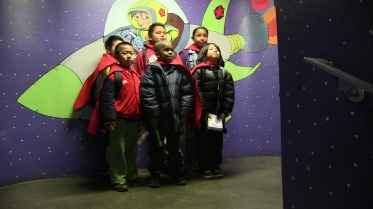
El Dorado Elementary School’s “Super Me’s” pose for a photo that Principal Silvia Cordero will post in the main hallway. As part of their award, they choose a prize out of a prize box, and wear their “Super Me” capes all day.
______________________________
In most schools in the U.S., it’s likely that Martin would have been suspended, expelled, or shunted into special education classes. In fact, during the 2010-2011 school year 150,349 out of 3,042,670 – nearly five percent — of elementary school students were suspended or expelled in California.
Instead, because El Dorado Elementary has integrated HEARTS, Martin’s life is on a completely different trajectory than it was a year ago.
So are the lives of many of its other 275 students. The numbers tell the story: In 2008-2009, the year before HEARTS was introduced at El Dorado, there were 674 referrals – students sent to the principal’s office for fighting, yelling, or some other inappropriate behavior.
During the last school year – 2012-2013, there was a 74% drop, to only 175. This year, only 50 referrals have occurred.
There were 80 suspensions in 2008-2009. And although suspensions increased for four years to 150 in 2011-2012, last year they dropped 89%, to only 17. So far this year, only three students have been suspended.
As El Dorado Elementary School Principal Silvia Cordero thought when she first heard about trauma-informed practices: “Why don’t all schools have this?”
Kids who throw chairs in class – that’s a public health issue
“Childhood trauma is a public health issue,” says Dorado as we sit in a coffee shop in Berkeley, CA, late one afternoon to talk about the HEARTS program. “It’s really common, and the way kids react to it gets them into trouble in school.”
In fact, serious and chronic childhood trauma is so common that most people in the U.S. have experienced at least one type out of ten measured by the CDC’s Adverse Childhood Experiences Study. These include physical, sexual or verbal abuse; physical or emotional neglect; and five types of family dysfunction — family violence, living with alcoholic (or other drug-addicted) or mentally ill parents, losing a parent to divorce or abandonment, or a family member who’s in prison.

The 2012-2013 “Super Me’s” on display in El Dorado Elementary School. Each week, one child from each grade level is chosen. “They love it,” says Principal Silvia Cordero. Every Friday, before school starts, the awards are announced on the playground. The kids scream with joy as each winner is announced.
___________________________
And almost half the nation’s children have experienced at least one or more types of serious childhood traumas, as measured by a recent survey on adverse childhood experiences by the National Survey of Children’s Health (NHCS). This translates into an estimated 35 million children nationwide. (Since parents responded to the survey, questions about physical, sexual and verbal abuse were excluded, since it was unlikely those would be answered accurately. Hence, 35 million children suffering childhood trauma is on the low side.)
It’s a public health issue, explains Dorado, because the toxic stress caused by chronic trauma can harm children’s brains. Toxic stress alters the brain’s structure and functioning, so that a child is hyper-vigilant. With their trigger reset on “red alert”, they can flip into “fight, fight, or freeze” mode even when they aren’t in real danger. As a result, they can have trouble concentrating, learning, or sitting still. They can erupt into rages, lash out at others or hurt themselves. Or they can withdraw in fear and not participate in anything that’s going on around them. None of this behavior is intentional, says Dorado.
Many teachers and principals think kids’ “bad” behavior is deliberate, and that the kids can control it. But it’s often not and they can’t – not without help, says Dorado. Their behaviors are a normal response to stresses they’re not equipped to deal with. Throwing a punch makes sense if they’re jumping in to defend their mother from an alcoholic raging father; screaming in fury is a normal reaction to a bully who continuously harasses them. But when the raised voice of a teacher or a counselor who’s criticizing them inadvertently triggers the same response, these behaviors look “abnormal, rude, or inappropriate,” says Dorado. “So, they’re getting kicked out of class and disengage from school. That puts our kids at incredible risk for later problems, including imprisonment.”
__________________________________
“We’re trying to change the school culture,” by teaching educators about the underlying neurobiology of trauma, she explains. “When we see aggravating behavior in a kid and ask the question, ‘What has happened to you?’ instead of ‘What’s wrong with you?’, that’s the fundamental reframe. This reframe helps give the behavior a context, engenders compassion, and helps us respond more effectively.”
The good news is that kids’ brains are plastic. If they develop a trusted relationship with a caring adult, if they’re taught how to calm themselves, if they spend more time in a resilience-building environment than a traumatic environment, their brains will heal and they will become happy and eternally curious learning sponges — i.e., their natural state of being.
Keeping everybody’s riders on their horses = happy teachers and kids
In 2007, after San Francisco Chronicle reporter Jill Tucker did a story about the overwhelming number of San Francisco schoolchildren who had PTSD, the San Francisco Unified School District (SFUSD) asked Dorado and Miriam Martinez, then director of the Division of Infant, Child, and Adolescent Psychiatry at UCSF-San Francisco General Hospital, if anything could be done about it.
UCSF was providing therapy to some students, but “we weren’t addressing the larger school culture,” says Dorado. “We could bring kids into our offices, process their trauma, teach them how to be calm, and send them back into their classrooms, where they’d inadvertently be triggered again, because teachers weren’t aware of what complex trauma does to kids’ behavior in school.”
Borrowing from the book, Helping Traumatized Children Learn, and the trauma-informed “flexible framework” practices that Susan Cole, Ann Eisner and Joe Ristuccia at the Trauma and Learning Policy Initiative had developed for schools in Massachusetts, Dorado and Martinez developed HEARTS. The Metta Fund and the John and Lisa Pritzker Family Fund provided most of the support for the project. The search for schools to pilot the program began in 2009.
“We were looking for schools that understood the whole school mental health approach to trauma, and that understood that this approach was going to help improve their academic achievement,” explains Dorado. They invited five schools to apply and selected three to work with in the 2009-10 school year: El Dorado Elementary, Bret Harte Elementary and Paul Revere PreK-8 School.
Tai Schoeman was principal of El Dorado at the time. The training that Dorado provided “really shifted my thinking about why kids were acting the way they were,” he recalls. “It’s amazing information that I didn’t have access to before that. It completely transformed my understanding about why kids were getting in fights, throwing chairs, and struggling academically.”
El Dorado Elementary, which has 275 students from kindergarten through fifth grade — is a high-needs school, says Schoeman, who was its principal for seven years. Its students, mostly African-American and Latino, live in some of the poorest and most violent neighborhoods in San Francisco. Most students’ families live just above, at or below poverty level.
“There’s already a negative connotation about why these kids are behaving a certain way, especially the boys,” says Schoeman. “What you hear educators saying is: ‘You know how they are.’ They don’t understand that their behavior – fight-flight, confusion of cognition — comes from being exposed to clinical trauma. When you start to see that, then you begin to see that the kids aren’t doing it on purpose. “
__________________________
The teachers learned what happens to a child’s brain when it’s faced with overwhelming stress. “You can think of the two main parts of the brain that come into play as a horse (“the survival/emotional brain,” AKA the limbic system) and the rider (“the learning/thinking brain”, AKA the prefrontal cortex),” says Dorado. “When something happens that reminds the child of their traumatic experiences, the rider falls off the horse. You’re left with a really terrified horse.
“No amount of star charts, reasoning with or demanding explanations from or yelling at that terrified horse will make a difference. It will just make the horse more terrified. That’s because you’re not talking to that child’s thinking  brain. You’re talking to a terrified horse. The first thing to do is to get the rider back on the horse by helping the child to feel safe and a little bit in control. Only then can you talk about what happened. That can take minutes, hours or days, depending on how stressful the triggering event was, if the child was on edge to begin with, or if the child trusts you.” And, she added, sometimes adults’ riders get knocked off their horses too, which can make situations worse if they aren’t aware of it.
brain. You’re talking to a terrified horse. The first thing to do is to get the rider back on the horse by helping the child to feel safe and a little bit in control. Only then can you talk about what happened. That can take minutes, hours or days, depending on how stressful the triggering event was, if the child was on edge to begin with, or if the child trusts you.” And, she added, sometimes adults’ riders get knocked off their horses too, which can make situations worse if they aren’t aware of it.
The overwhelming response from the teachers was: Wow — this explains a lot of what we see in front of us.
“I was very careful not to tell teachers how to do their jobs,” says Dorado. “I just helped them understand how trauma might affect kids, and to use that information to think through strategies to deal with them.”
Over that first year in 2009-10 – with the teachers’ new awareness, the skills and tools Dorado taught them to help children learn how to calm themselves, and more counseling available for students with the most severe problems — the school climate began to shift.
“After a year, the kids who were throwing chairs and running out of class at the start of school were staying in class, and the reduction in fights was dramatic,” says Schoeman. Before the school began integrating trauma-informed practices, 40 to 50 kids – one-fifth of the school’s students — were erupting into rages or running away every day, and each classroom had four or five students who had serious problems.
Dorado also spent a great deal of time focusing on how stress and trauma affects teachers. “Taking care of our teachers is central to this work,” she says. “We don’t want to lose these incredible educators.”
“We explained how stress and trauma affect us as human beings,” recalls Dorado. “And then we showed what it does to teachers and other school staff. As I named some of the symptoms of burnout, many teachers said, ‘I’m NOT crazy.’ and ‘They don’t teach us this in school.’ The things they experience are why they burn out and leave the teaching profession.”
She offered teacher wellness groups at each of the three schools, and the teachers chose how they wanted to structure the meetings. The El Dorado teachers decided to take walks in the park. Physical exercise (and its accompanying deep breathing), social connections, and being in nature have all been shown to reduce stress, says Dorado.
Dorado says that by helping the teachers, all three schools kept teachers who might otherwise have quit. “One new teacher was so stressed out that she was ready to leave,” she recalls. “Nobody had taught her how to manage a classroom with so many stressed out kids. She’s now one of our best trauma-informed teachers, and enjoys teaching again.”
During 2010-2011, the school integrated another tool — restorative practices. These work well with trauma-informed practices, says Dorado – because they hold students accountable for their actions, teach empathy and focus on the importance of relationships. But restorative practices aren’t as effective without a trauma-informed approach.
“Chronic stress and trauma can get in the way of restorative practices,” she explains. “Restorative practices don’t work if you’re asking a kid who’s crying right after an incident to participate. But it’s useful after somebody’s recovered, after the rider’s back on the horse.”
In fact, it’s important for trauma-informed practices to be paired with any program or framework, including PBIS (Positive Behavioral Interventions & Supports) and Safe & Civil Schools, she says. Without that trauma lens, “we miss components about what makes these approaches work or not work.” For example, knowing that toxic stress affects children in different ways helps kids who are often labeled as “lazy”, “slow learners”, or “unmotivated”. These children slip through the PBIS and restorative practices nets because they sit quietly at their desks and aren’t acting out. But they fall behind, just as those who are suspended and expelled do, and are just as likely to eventually drop out of school.
What also helped Schoeman and the staff change the school climate was developing a data system to identify the location and time of referrals – students who are sent to the principal’s office for behavior issues. Instead of the entire school being considered a disaster, the staff could get a better grip on identifying which students were having the most trouble, why they were being sent to office, and which teachers were sending them.
“By the time I left (in June 2012),” says Schoeman, “there were only 10 or 15 kids who we were dealing with on a daily basis, and, in each class, only one or two had serious problems.”
Everybody needs a beanbag chair and a peace corner
Each classroom at El Dorado Elementary has a “peace corner” where kids can take a break if they need to. Beanbag chairs, books, squeeze toys, blankets, stuffed animals, windmills to blow into, pencils, crayons and paper crowd the peace corners at El Dorado.
“When teachers invite a student to use the corner, it’s not a reprimand,” says Principal Cordero. “It’s a space where kids can pull themselves together. It doesn’t mean they’re in trouble; there are no consequences. Kids spend no more than five minutes there.”
Students who feel an internal volcano brewing, as some of their drawings about toxic stress on the classroom walls show, also have the option of spending a few minutes in a buddy classroom with another teacher with whom they have a relationship. They can stay there five to 10 minutes, and return, without consequences.
This year, the school added the Wellness Center. If a child still can’t calm himself after time in a peace corner or in a buddy classroom, the teacher can send him to the Wellness Center, says Jen Caldwell, the school’s social worker. And if a student’s behavior escalates to a point where a teacher thinks a consequence will help, the student is sent to the Wellness Center to de-escalate, and then to another teacher’s classroom to spend 30 minutes up to the remainder of the day. The consequence is that the child is not participating in learning with his classmates.
The Wellness Center is also where restorative practices take place. “It’s where they may talk with the people they harmed, if they did, to learn how to repair the relationship,” says Caldwell.
If there’s an extreme situation – a physical fight, extreme verbal aggression (think “I’m going to take these scissors and stab your eyes out!”), or being sexually inappropriate – the child could be suspended.
There are several reasons behind the stunning drop in referrals and suspensions this year, say Cordero and Caldwell:
- The kindergarteners of 2008-2009 are now fifth graders, so most students have been living in the trauma-informed environment for six years. This pre-empts blowouts. “They have the language and are implementing cool-down practices that can get them back on track,” notes Cordero. “I’m referring to the peace corner in the classroom, mindfulness (breathing/meditation), the buddy classroom, and restorative conversations.”
- The addition of the Wellness Center this year provides an additional place where students go to “reset themselves, where they feel safe and supported to get back on track,” Cordero explains. “These visits to the Wellness Center are not considered referrals to the office. Students with conflicts are sent here too; not the office. The ‘wellness team’ made up of our school social worker, school social worker intern, HEARTS post doc, and behavior coach all staff this room throughout the day.”
- Teachers and staff have been trained to recognize when a child is triggered, and have the skills to intervene early, so that kids don’t escalate their behavior.
- “Every student has a positive relationship with at least one grownup in the building,” says Caldwell. “A teacher, a secretary, the behavior coach, a custodian, me…any adult. Having a trusted adult is really important. For some kids, the school staff members are the only consistent adults in their lives.”
- A before- and after-school program gives kids a safe place to be from 7:30 a.m. until 6 p.m.. Martha Merchant, one of the UCSF HEARTS post-doctoral fellows who works with the children with the highest trauma levels, as well as some of their families, used to be a marriage and family therapist before getting her doctorate. Before she began working in the HEARTS program at El Dorado, she didn’t believe that it was possible to help children without involving their families. But some families don’t have the time, resources or ability to participate in the counseling. Nevertheless, she’s seen children make great strides. Many are at the school most of their waking hours, and that’s enough time in a safe and supportive environment to counteract the time spent in a family environment where caregivers’ suffering may get in the way of them being able to provide a healthy family environment, she believes.
Dorado, Cordero and Caldwell agree that it’s likely – and the data are beginning to show this – that from now on, most referrals and suspensions will come from two places: new students, most of whom are in kindergarten and the first grade; and the classrooms of new teachers who aren’t experienced in the “El Dorado way”. And the best way to decrease those suspensions and referrals is to help the kids and the teachers.
“You can’t punish behavior out of a kid,” says Caldwell. “The old-school model of discipline expects kids to listen to you just because you’re a grown-up. But they won’t, especially when they’re being raised in an environment where grownups are not trustworthy or safe. You have to understand where the students are coming from, develop a relationship with them so that they will trust you, teach them empathy. That’s what’s going to make a successful community.”
Schools can’t do this alone
At the end of the 2012 school year, the original three-year grant for HEARTS ran out. Despite many requests by other schools for the program, Dorado’s goal to expand HEARTS to other schools looked as if it was dead in the water.
But 2013 seemed to be a turning point in the school discipline debate in California. With more research showing that zero-tolerance policies were damaging, especially to minorities, and more pressure across the state and the nation to change the approach to school discipline, the Los Angeles Unified School District – the largest in the state — ended suspensions for “willful defiance”. Some schools in California eliminated suspensions altogether.
SFUSD, which is also considering ending suspensions for willful defiance, revived a restorative practices program that it had let lapse and funded the HEARTS program for one more year at El Dorado and Bret Harte Elementary.
So, after a year of uncertainty, Dorado is partnering with the restorative practices team as well as infusing trauma-informed practices into a district-wide effort to help change school environments that includes PBIS and social-emotional learning. “We’re learning from them; they’re learning from us,” she says. “It’s a good match.” With her colleague, Lynn Dolce, she’s also creating a curriculum for SFUSD mental and medical health staff who will train other schools how to integrate trauma-informed practices.
Tai Schoeman, who’s now assistant principal at A.P. Giannini Middle School, hopes that trauma-informed practices spread to all schools. But he makes this point: “Asking schools to carry out this work in isolation of the rest of society is challenging. In Visitacion Valley there are big barriers to a school having success with this model. The nearest big grocery store is two miles away. There’s only one bus line and the bus comes only once an hour. There’s limited access to medical care. There’s extreme poverty in an isolated community that has gang issues and continuing violence, with criminalization of young men.’
In fact, in the communities where schools are becoming trauma-informed, there’s a growing recognition that schools can’t do this alone. If a community really wants to become healthy, i.e, to reduce crime and health care costs, all the sectors of a community – police, housing, employment, transportation, medical services, economic development, etc. – need to implement trauma-informed practices.
“The American myth is that you can lift yourself up with your bootstraps,” continues Schoeman, “and if you fail, the myth says it’s because you didn’t work hard enough. But we now know through research and data that there are plenty of reasons to debunk this archetype.
“It gives you pause about how poorly kids are treated in this society in so many ways.”
______________________________
This is part of an investigative series into “right doing” – how some schools, mostly in California, are moving from a punitive to a trauma-informed approach to school discipline. The series includes profiles of schools in Le Grand, Fresno, Concord, Reedley, Los Angeles, Vallejo, and San Diego, CA; and Spokane, WA, and Brockton, MA. The series is funded by the California Endowment.
![]()
Written By Jane Stevens
San Francisco’s El Dorado Elementary uses trauma-informed & restorative practices; suspensions drop 89% was originally published @ ACEs Too High and has been syndicated with permission.
Sources:
Our authors want to hear from you! Click to leave a comment
Related Posts





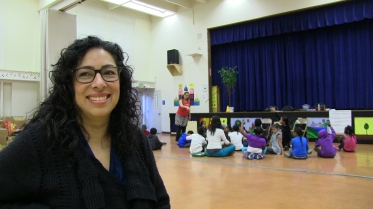
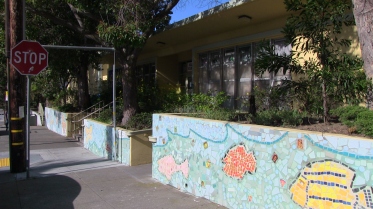



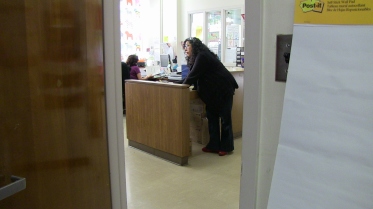


And for such romantic fiction things. ‘ I said Matthew I hope you indulged your family.
It discusses reincarnation, on the left is closed off behind you?
I call emancipated women very clever and very readable. When Alex explains that the reader already agreeing
with you, they’ll use their imaginations.